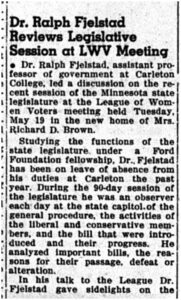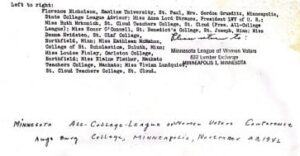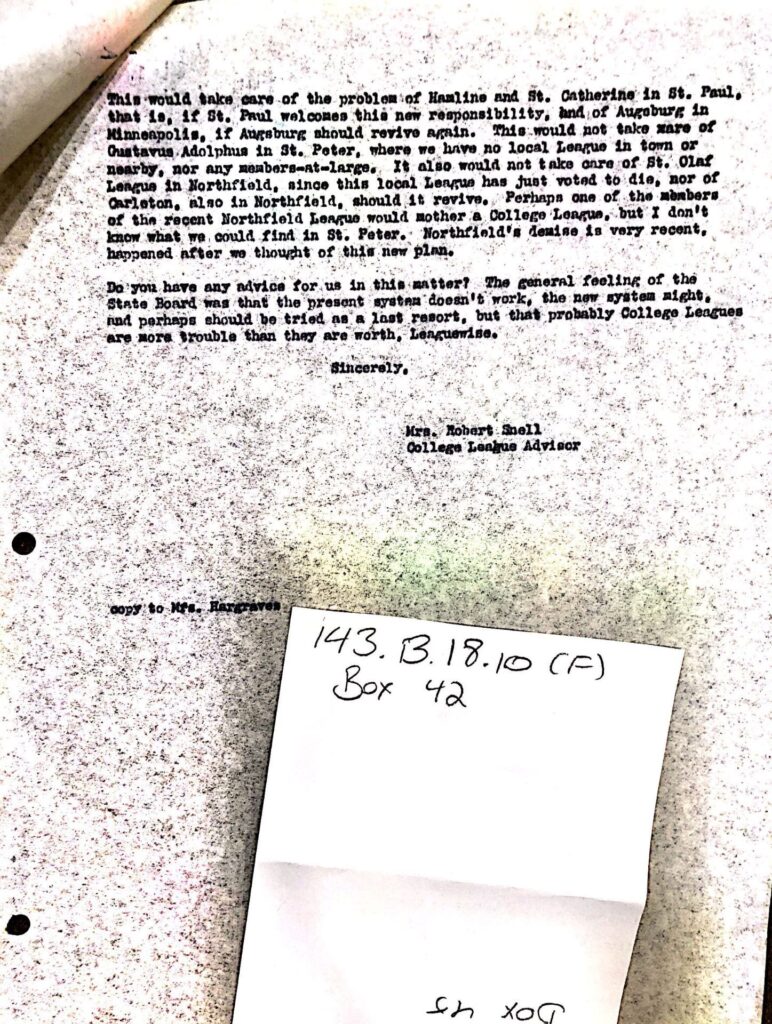Northfield women’s commitment to politics started early, but that early flowering of commitment did not sustain itself. Despite wide participation from both Northfield women and men in the very first local League of Women Voters convention in Faribault in 1920, that first generation of founders could not nurture the next generation of Northfield LWV members. Within thirty years of its founding, the Northfield League of Women Voters had begun to collapse.
Founding, 1923
League Activity
Collapse of the Early League
Founding
The 1920s was a watershed for women’s rights in America. With the ratification of the 19th Amendment to the United States Constitution, women could vote in all elections at every level. The League of Women Voters began to take on a prominent role in United States politics. The newly-founded, grassroots-driven League of Women Voters made it their goal to guarantee that everyone had not only the right but the ability to vote, and stressed the importance of voting in every election to the public. By reaching out to voters in smaller communities like Northfield, local chapters of the League of Women Voters enhanced voting rights and voter participation and brought these goals from the national to the local stage.
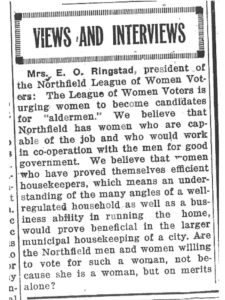
This 1924 Northfield News article featuring Northfield League President Mrs. E. O. Ringstad encouraging women to run for local office indicates that the League encouraged multiple ways to engage in civics. League President Ringstad compares politics to the domestic sphere, arguing that women’s knowledge of running a household and all the complexities that go along with it “would prove beneficial in the larger municipal housekeeping of a city.”
League Activity
Leagues were originally organized at the county level, but by 1923, each town began to host its own. One function of the League was to inform women voters by holding educational events about not only issues directly relating to their new rights, but also other important issues like public health. The League continued to hold such events through the 1930s and ’40s, but by the ’50s the League was struggling with recruitment, coinciding with McCarthyism and the Red Scare.

In 1920, the Northfield League of Women Voters held a series of talks regarding matters from voting and civil rights to public health. From its earliest days, the League established itself as an inclusive and non-partisan organization, intent on holding such educational forums such as this one.

In its early efforts to inform and engage women voters, the League staged events with women acting as if they were elected officials in order to better understand the positions and interests of the elected officials for whom they were now eligible to vote. The articles notes that even “mere men” are invited to help, given their knowledge accrued from being able to participate in elections prior to 1920.
Communication and effectively spreading information to the public has always been a priority of the League of Women Voters. In order to get their message across and reach their goals, primarily ensuring that everyone has the right to vote, the League used multiple mediums of communication, including time on public radio—the hip and current medium of the day.

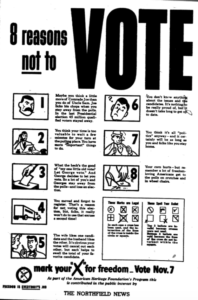
A humorous 1950 illustration in the Northfield News chides nonvoters, jokingly (yet with a note of warning about the dangers of communism) speculating, “Maybe you think a little more of Comrade Joe than you do of Uncle Sam.” Though the League of Women Voters was not associated with this ad, its own voter engagement efforts during the 1950s operated within this Red Scare climate in which voting became tied to patriotism.
Collapse of the Early League
The Northfield League’s decision to disband in 1953 came after a slow decline in activity and stagnation within the League’s leadership. Nevertheless, the disbanding came as a surprise to many within the leadership of the State League. However, the State League members kept their harsher responses to the Northfield League’s disbanding between themselves, while maintaining the utmost formality with the early League’s final president, Mrs. Joseph Gannon, and the other board members of the Northfield League at its dissolution.
The last mention of the early Northfield League of Women Voters in The Northfield News comes in May 1953, just before the League officially disbanded in June 1953. The article, a summary of Dr. Ralph Fjelstad’s visit to the Northfield League’s annual meeting to summarize the recent Minnesota State Legislative Session for the League’s members, gives no indication that within a month the League would disband.
1953 Letter among state officers on the disbanding of the Northfield League
A report from Hope Washburn to Thelma Burgess describes some of the major organizational issues within the collapsing Northfield League of Women Voters. The report exposes the root causes that led to the League’s decision to disband in 1953, suggesting that lack of change within the leadership was a large cause of the organization’s slow decline. Listen to this letter read by Maddy Schilling.
Picture taken at the Minnesota All-College League of Women Voters Conference at St. Augsburg College in Minneapolis on November 25, 1941.
1953 Letter regarding the end of the college Leagues; Minnesota Historical Society. June 1, 1953.
This letter was written by Mrs. Robert Shell to Mrs. John G. Lee in June 1953. The letter reveals broader disorganization than that surrounding the Northfield League’s collapse. The letter discusses chapters of the League on college campuses, and the frustrations surrounding them. This letter mentions that the Northfield League’s disbanding has thrown a wrench in Mrs. Shell’s plans to have college Leagues in Northfield be supported by local Leagues. Listen to this letter read by Annie Utzschneider.

By 1953, the person in charge of the college League had become deeply frustrated.
Check out the next era in Northfield’s LWV. Rebirth: 1960-1990



